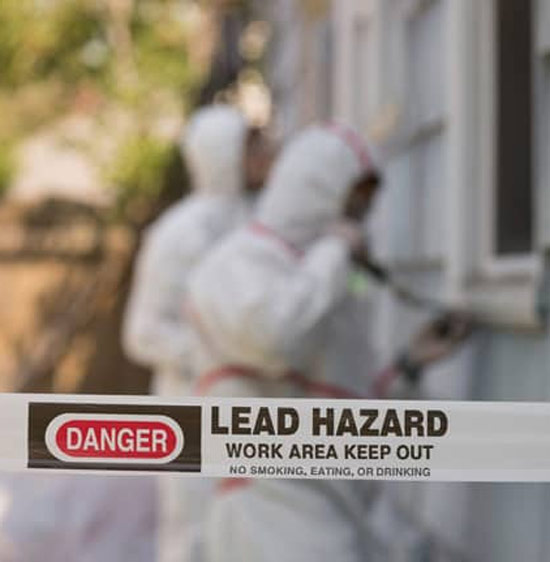NYC Lead Paint Removal Company-- Guaranteeing Safe and Lawful Conformity
NYC Lead Paint Removal Company-- Guaranteeing Safe and Lawful Conformity
Blog Article
Ideal Practices for Making Sure Safe and Thorough Lead Infraction Abatement
Attending to lead infraction abatement calls for a multi-faceted technique to make sure both security and conformity. Preliminary assessments making use of sophisticated discovery approaches such as XRF analyzers set the phase for a precise understanding of contamination degrees. Integrating correct containment strategies, including closed barriers and HEPA filtration, coupled with making use of individual protective tools (PPE) for workers, forms the backbone of a protected operation. Careful clean-up procedures, including HEPA vacuuming and wet-wiping, are vital. It's the final clearance process, including complete inspections and research laboratory testing, that truly validates a lead-free environment, ensuring long-term safety and security. Exactly how do these practices adjoin to ensure thorough lead abatement?

Initial Analysis
Performing a first assessment is an important initial step in lead infraction reduction. This stage includes a comprehensive examination of the residential or commercial property to determine the presence, level, and certain places of lead-based risks. Certified experts, such as certified lead assessors or risk assessors, need to do a thorough website assessment, using devices like X-ray fluorescence (XRF) analyzers to accurately detect and measure lead concentrations in paint, dust, dirt, and water.
The analysis must likewise consist of a review of the building's history, previous records, and any kind of complaints or health concerns reported by owners - Lead Removal Contractors. Recording the findings carefully is vital, as these documents form the basis for developing a reliable abatement approach. A complete evaluation additionally includes tasting and laboratory analysis, which are essential to validate the presence of lead and guide succeeding activities
Furthermore, it is essential to interact the results transparently to all stakeholders, consisting of homeowner, occupants, and regulative authorities. By making certain that the preliminary assessment is performed with precision and roughness, specialists can lay a solid foundation for a targeted and efficient lead abatement procedure, inevitably guarding public health and wellness and making certain conformity with regulatory criteria.
Correct Containment
Appropriate containment is vital to stop the spread of lead pollutants during abatement activities. Efficiently managing control lessens the risk of lead dust and debris moving to non-work areas, consequently protecting both the atmosphere and people outside the prompt work area.

Regular examinations of the containment location are required to check for breaches or weak points in the obstacle. Any type of recognized issues should be quickly resolved to maintain the integrity of the containment. By adhering to these methods, abatement projects can effectively regulate lead contamination and minimize associated wellness risks.
Employee Defense
Ensuring employee protection is extremely important throughout lead reduction jobs to stop work-related direct exposure to dangerous lead particles. Important actions include the use of personal safety equipment (PPE) such as respirators, gloves, and full-body suits specifically developed to block lead dust and fumes. Employees ought to undertake extensive training on the appropriate usage and maintenance of PPE, consisting of fit testing for respirators to make certain optimum efficacy.
Engineering controls, such as neighborhood exhaust air flow systems, are critical in lessening air-borne lead focus in the workplace. Administrative controls should also be executed, including limiting the duration of direct exposure and revolving workers to lower private direct exposure times. Regular clinical security and organic tracking are important for very early detection of lead absorption, enabling timely intervention and treatment.
Additionally, developing a decontamination protocol is important. Workers have to follow stringent purification treatments prior to breaks and at the end of their change to prevent lead dirt from being brought outside the work area. This consists of complete hand and face washing with lead-specific cleaning agents and changing out of polluted apparel.
Meticulous Clean-up
Keeping a secure workplace go right here prolongs past worker protection and encompasses precise cleanup to make sure lead particles are completely gotten rid of from the site. The procedure of careful clean-up is essential in avoiding the recontamination of the eased off location and safeguarding both current and future owners.
To achieve a comprehensive clean-up, all workplace must be systematically decontaminated. This entails making use of specialized HEPA (High-Efficiency Particulate Air) vacuum cleansers and wet-wiping techniques to capture and get rid of great lead dirt that might have picked surface areas. It is vital to cleanse all straight surface areas, consisting of floorings, window sills, and countertops, as well as upright surfaces that may have caught lead fragments.
Employees have to wear suitable individual protective equipment (PPE) throughout cleanup to stay clear of direct exposure to recurring lead dust. Made use of cleaning products such as wipes, sponges, and mop heads need to be disposed of according to contaminated materials disposal guidelines.

Final Clearance
Last clearance is the critical concluding phase of lead abatement that identifies whether the website is risk-free for reoccupation. This important action includes thorough inspection and testing to verify that all lead dangers have been efficiently removed.

Last clearance testing not just shields future occupants but also makes sure compliance with local, state, and government policies. It offers as a recorded recognition of the reduction specialist's adherence to industry best methods. Ensuring a detailed and successful last clearance is important in securing public health and wellness and fostering rely on the abatement procedure.
Final Thought
Guaranteeing safe and detailed lead infraction reduction requires a diverse technique incorporating first assessments with sophisticated detection techniques, efficient control strategies, rigid employee defense methods, and thorough cleaning treatments. The final clearance phase, including thorough assessments and laboratory screening, is vital to confirm conformity with EPA criteria. Adherence to these finest practices ensures a safe atmosphere for passengers, reduces wellness dangers, and promotes regulatory needs, thus promoting public health and safety and security in lead-affected locations.
Report this page